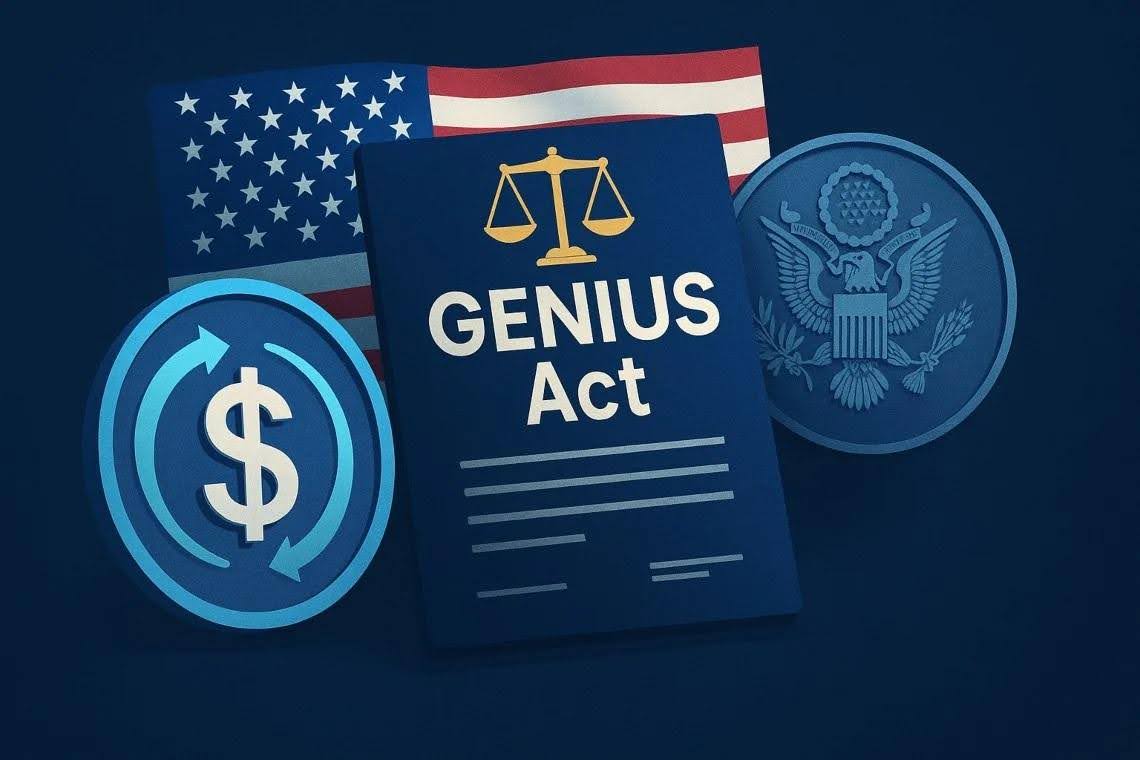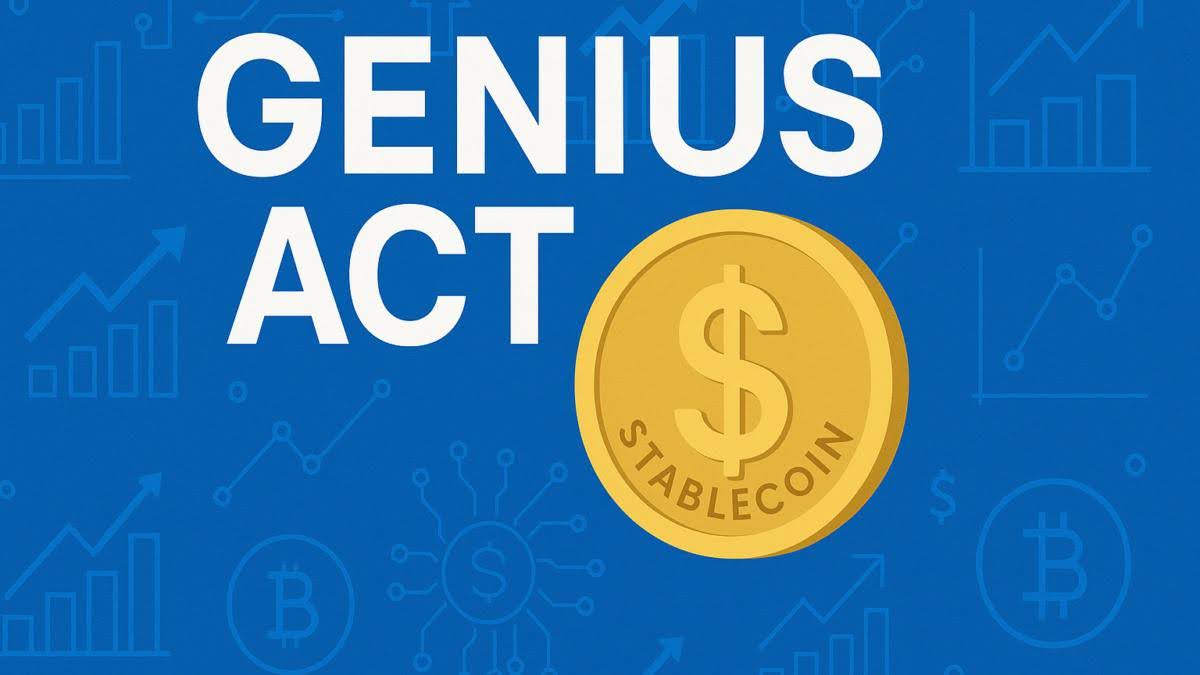GENIUS Act 2025 – All You Need to Know About This New Stablecoin Regulation

What Is the GENIUS Act? Understanding the Basics
The GENIUS Act — whose formal name is Guiding and Establishing National Innovation for U.S. Stablecoins Act — will represent the most significant leap forward in U.S. financial law, a clear statement from Washington that payment stablecoins is a fundamental part of the emerging digital economy. Where other regulatory proposals have been broad, general and focused more broadly on crypto assets, the GENIUS Act takes a targeted approach to payment focused stablecoins comparing them to, for example, algorithmic tokens, commodity backed crypto, or other decentralized finance instruments.
Instead of imposing a one-size-fits-all regulatory approach, the GENIUS Act establishes a two-tiered regulatory framework which allows federal and eligible state regulators to license and supervise stablecoin issuers. This flexible architecture enables existing state-chartered entities direct access to the modular financial system and preserves a solid federal safety net — a design principle that is meant to trade off innovation and systemic risk management.

Read More: U.S. Senate Passes the GENIUS Act — What’s Really Inside the $3.7 Trillion Crypto Bill?
As digital counterparts to fiat — and the U.S. dollar in particular — stablecoins are being woven ever more deeply into the fabric of remittance platforms, blockchain settlements, e-commerce and mobile finance. The GENIUS Act provides an important policy answer: how to regulate dollar-pegged digital currencies without unduly stifling their utility and possibility for innovation.
Moreover, the bill incorporates language that supports a range of regulatory aims, including anti-money laundering (AML), countering terrorist financing (CTF), and systemic risk prevention — such that the US adoption of stablecoins does not leave regulatory gaps or weak points in the national financial structure.
How GENIUS Act Begins? Who Supports It?
The GENIUS Act didn’t appear overnight. It came amid mounting pressure for lawmakers, regulators and industry leaders to come up with clear federal rules for stablecoins, after years of fragmented oversight. Its path demonstrates bi-partisan cooperation and thorough analysis – putting the U.S. on track to become a global leader in how it regulates digital assets.
- October 2024: A public draft of the GENIUS Act was published, inviting feedback from industry, consumer protection entities, as well as the public.
- February 2025: Then it was officially introduced in the Senate by Sen. Tim Scott, after months of working with finance and crypto stakeholders.
- March 2025: The Senate Banking Committee approved the bill with nearly 40 amendments offered by both sides, on issues from reserve requirements to state-federal coordination.
- May 19, 2025: The Senate approved the GENIUS Act in a 66–32 vote, with almost every Republican supporting it and five Democrats dissenting — a breakthrough moment for stablecoin policy.
Read More: Senate Shocker: 15+ Democrats Flip as GENIUS Act Clears Key Hurdle in 66-32 Vote
Here are some key supporters behind the bill:
- Senator Tim Scott (South Carolina): The bill’s lead sponsor, Senator Scott serves as the Chairman of the Senate Banking Committee and moved the legislation to create regulatory certainty for the digital economy.
- Senator Bill Hagerty (Indiana): Pushed for fintech-friendly policies and advanced innovation in digital assets under sound supervision.
- Senator Kirsten Gillibrand (New York): Longtime Supporter of Sensible Crypto Legislation and Coauthor of previous digital asset bills.
- Senator Cynthia Lummis (Wyoming): Chair of the Senate’s first Subcommittee on Digital Assets, this brings deep expertise and leadership on blockchain issues.
- Senator Angela Alsobrooks (Maryland): Another young lawmaker, who saw the passage of the GENIUS Act as a sensible regulatory approach for the future.

The bill also received strong support from the crypto industry. Ripple CEO Brad Garlinghouse described the GENIUS Act as the U.S.’s most significant financial legislation since Dodd-Frank, and added that the bill proved that it is possible to balance technology with accountability. Other digital asset companies, like Coinbase, also praised the clarity the bill offers.
With Senate approval now in hand, the GENIUS Act heads to the House, where it should further codify the U.S. stance on stablecoins and shape worldwide policy on digital finance.
What Does the GENIUS Act Aim for?
The GENIUS Act is focused on the consumer and financial protection aspects of this area by creating a robust federal structure for regulating payment stablecoins. It’s just good standard-setting, which raises transparency, blocks abuse, and lowers systemic risk. The key tenets of the GENIUS Act are summarized as follows:
Goal 1: Ensure Full Reserve Backing for Stablecoins
- All payment stablecoins should have to invest 100% reserves in U.S. dollars, short-term Treasuries, or other instruments approved by regulators.
- This aims to prevent depegging and ensures stablecoins maintain their 1:1 value.
Goal 2: Increase Transparency Through Public Disclosures
- Issuing banks have to publicly disclose their reserve make-up on a monthly basis.
- Issuers with more than $50 billion in market cap would have to disclose annual audited financial statements.
- These make it possible for consumers to trust issuers and for investors to determine the solvency.
Goal 3: Prohibit Misleading Marketing and Brand Misuse
- It is unlawful for any issuer to market stablecoins as being:
• Guaranteed by the U.S. government
• Covered by FDIC insurance
• Backed by the full faith and credit of the United States - Stablecoins must not be advertised in a way that leads consumers to believe they are legal tender or government-issued.

Goal 4: Prevent Destabilizing Market Runs
- The act enforces strict reserve asset rules to mitigate risks, including:
• Diversification requirements for reserves
• Bans on holding riskier assets like corporate debt or equities
• Interest rate risk management standards
• Capital and liquidity risk management requirements - These measures protect against sudden withdrawals or market shocks.
Goal 5: Clarify the Role of State vs. Federal Oversight
- The GENIUS Act allows qualified state regulators to oversee issuers—but only if their frameworks are “substantially similar” to federal standards.
- Issuers exceeding $10 billion in issuance must:
• Come under federal oversight,
• Seek a waiver, or
• Cease new token issuance if they fail to comply.
Goal 6: Protect Stablecoin Holders in Insolvency Cases
- Stablecoin holders have priority claims over all other creditors in the event of issuer bankruptcy.
- The act mandates expedited court reviews and ensures reserves are returned quickly and fairly to token holders.
What Are the Pros and Cons of the GENIUS Act?
What the GENIUS Act gets in terms of benefits however, it does lose in acquiring fair critiques among industry participants.
The pros of the GENIUS Act are listed below:
- Enhanced Consumer Trust: Rules of the road and reserve requirements will instill a heightened trust in stablecoin issuers.
- Market Stability: Defined regulatory structure may reduce the risk of runs and systemic shocks.
- Clarity for Innovators: Developers and investors now have a roadmap for compliance.
- National Security Benefits: AML/auditing requirements promote financial transparency.
The cons of the GENIUS Act are listed below:
- Compliance Costs for Startups: Smaller issuers may struggle to meet reserve and audit standards.
- Risk of Overregulation: Excessive oversight might stifle rapid innovation.
- Federal-State Friction: Federal and states regulators may not be well coordinated, which might create delays or clashes.
- Exclusion of Algorithmic Stablecoins: The bill does not include non-collateralized stablecoins, and thus fails to capture a whole category of stablecoins.
What Are the Main Points of the GENIUS Act?
Rather than just imposing reserve requirements or a ban on deceptive marketing, the GENIUS Act 2025 adopts a layered regulatory framework, which suggests a nuanced understanding of payment stablecoins’ place in the wider financial system. The law covers more than just cursory oversight—it’s an offensive blueprint to bring stablecoins into the U.S. financial system while keeping systemic risk, consumer protection, and national competitiveness in check.
Below are the key elements and less-discussed but equally important provisions that form the core of the GENIUS Act:
Establishment of a New Regulatory Category: “Permitted Payment Stablecoins”
One of the most foundational contributions of the GENIUS Act is the legal categorization of a new class of digital assets known as “Permitted Payment Stablecoins.” This classification:
- Distinguishes stablecoins that are used for consumer transactions from other digital assets, such as utility tokens or investment contracts.
- Mandates all stablecoin issuers to have to obtain a formal designation and approval if they want to circulate stablecoins within this section.
- Clears way for stablecoins to one-day plug into mainstream payment infrastructures – banking apps, merchant platforms or remittance corridors.
This step opens the gates for mass adoption by institutional and retail payment providers.
Interagency Coordination and Regulatory Roles
The GENIUS Act does not consolidate stablecoin regulation under a single agency, instead requiring cooperation among several federal regulators, such as:
- The Federal Reserve: Systemic risk oversight and impact on monetary policy.
- The OCC (Office of the Comptroller of the Currency): Regulates stablecoin-issuing companies that resemble digital banks.
- The SEC and CFTC: Ensures that stablecoin activity does not run afoul of securities or commodities law.
This approach mirrors a hybrid oversight framework like that holding sway over traditional financial entities; stablecoins cut across the lines of payments, investment and systemic infrastructure.
Regulatory Trigger Thresholds Based on Scale
The act also introduces a tiered regulatory framework where the degree of oversight escalates with the issuer’s market size. For instance:
- Issuers with market capitalization under $10 billion can operate under state regulation, provided their framework aligns with federal standards.
- Once they exceed $10 billion, they must seek additional oversight by a federal payment stablecoin regulator, request a waiver, or cease further issuance.
This dynamic structure ensures early-stage innovators are not overburdened, while large-scale issuers face robust safeguards due to their potential to impact national financial stability.
Bankruptcy Process Acceleration and Legal Priority
In case of issuer insolvency, the GENIUS Act introduces judicial mechanisms to expedite the bankruptcy process:
- It mandates that reserves backing permitted stablecoins be promptly distributed to holders, minimizing losses and uncertainty.
- The act grants first-priority creditor status to stablecoin holders, overriding claims from investors, vendors, or even internal shareholders.
This provision turns stablecoins into a safer asset class by giving users clear, court-enforced recourse—an innovation rarely seen in the digital asset world until now.
Regulatory Enforcement Powers and Penalties
Another significant point is the GENIUS Act’s provision for civil and criminal enforcement mechanisms. These include:
- The ability for regulators to fine or shut down issuers who misrepresent reserve holdings or market non-compliant stablecoins.
- Expanded powers to pursue cross-border enforcement, especially in collaboration with foreign regulators where stablecoins operate globally.
The inclusion of strong enforcement provisions elevates the act from a compliance guide to a powerful legal tool, enabling meaningful accountability.
Clarification of Legal Status in Commerce
The act also helps clarify where and how permitted payment stablecoins can be used by defining:
- That they are not legal tender, and cannot be forced as a method of debt settlement unless agreed upon by both parties.
- That they can, however, be used for digital commerce, payroll, cross-border payments, and other functions as long as they comply with regulatory permissions.
This clarification reduces friction between traditional legal systems and Web3 payment systems and opens room for corporate adoption without legal ambiguity.
Preventing “Shadow Stablecoins” and Brand Misuse
In an effort to stop confusion and fraud, the act includes strong provisions around naming rights and consumer perception:
- Only assets approved under the GENIUS framework may be called “payment stablecoins.”
- It is illegal to design user interfaces, wallet experiences, or branding that suggest regulatory approval where none exists.
This provision effectively eliminates the gray zone of pseudo-stablecoins and protects consumers from deceptive UI/UX tricks or misleading app store listings.
Support for Technical Auditing and Risk Modeling Standards
The act also mandates collaboration with academic and financial research institutions to create:
- Technical standards for stress testing and reserve simulations.
- Risk disclosure frameworks for issuers to share operational and technological risk assumptions with regulators and the public.
This brings a level of scientific and engineering rigor to crypto that has long been missing and signals the U.S. intent to lead not just through policy, but through technical excellence.
Encouragement of Innovation Through Legal Clarity
By clearly defining which activities are permitted and which are not, the GENIUS Act:
- Removes uncertainty for builders and developers, unlocking innovation by eliminating regulatory fear.
- Encourages venture capital and institutional funds to re-enter the space, especially those previously sidelined by lack of federal clarity.
- Positions the U.S. as a “rules-based innovation hub” for digital finance, rivaling jurisdictions like Singapore, Switzerland, or the UAE.

GENIUS Act vs. Stable Act: A Detailed Comparison
While the GENIUS Act focuses on fostering innovation with safeguards, the Stable Act is often viewed as more restrictive and enforcement-heavy.
| Feature | GENIUS Act | Stable Act |
| Definition | Establishes a flexible federal framework for payment stablecoins | Requires all stablecoin issuers to obtain bank charters and FDIC insurance |
| Regulatory Body | Shared between federal agencies and state regulators | Primarily federal oversight via the Federal Reserve and OCC |
| Reserve Requirements | 100% reserve backing with cash or Treasuries | 100% reserve backing with bank-level standards |
| Innovation Approach | Encourages compliant innovation | Focuses on consumer protection through heavy enforcement |
| Marketing Restrictions | Explicit bans on misleading government affiliation | Broad restrictions with criminal penalties |
Regulatory Approach
The GENIUS Act and the Stable Act both seek to regulate stablecoins in the U.S., but they differ significantly in how they approach oversight. While the GENIUS Act supports innovation through a flexible, risk-based framework, the Stable Act adopts a more restrictive model rooted in traditional banking oversight.
- GENIUS Act:
Focuses on creating a federal framework that encourages responsible innovation by allowing non-bank entities to issue stablecoins under clear regulatory standards. It introduces tiered oversight depending on issuer size, supports state-federal coordination, and emphasizes transparency, risk management, and consumer protection without stifling startups or new entrants. - Stable Act:
Centralizes financial activity around banks and the Federal Reserve, insisting that all stablecoin issuers must be chartered as banks and supervised as full-service national banks by the federal government. It emphasizes financial stability and the prevention of systemic risk, but critics say it could stifle innovation by restricting who can issue stablecoins, allowing only regulated banks.
Impact on Industry
- Fintechs and Startups: The GENIUS Act embraces modular compliance while the Stable Act may kneecap non-bank players.
- Banks: GENIUS encourages partnerships with tech firms; Stable Act reinforces bank dominance.
- Retailers and Tech Giants: GENIUS enables payment integration; Stable Act could limit private stablecoin initiatives.
Professionals and Politicians’ Opinions About GENIUS Act
The GENIUS Act has prompted a lot of feedback from politicians, financial professionals, and digital asset proponents. Some view this as a balanced and more forward-thinking approach to stablecoins regulation, while others are worried about the long-term implications — particularly when compared to the more conservative Stable Act.
- Positive views on the GENIUS Act:
- Brad Garlinghouse, CEO of Ripple, called it “the most important digital asset legislation since Dodd-Frank.”
- Senator Tim Scott emphasized that the bill “creates clarity without killing innovation,” highlighting its industry-informed development process.
- Coinbase and other crypto firms view the act as a productive compromise that encourages growth while imposing necessary safeguards.
- Critical views on the GENIUS Act:
- Privacy advocates warn that it lacks clear protections for anonymity and may increase surveillance risks.
- Small fintech startups argue that even with a flexible framework, compliance costs could be high, especially for those nearing the $10 billion issuance threshold.
- Traditional banks and some policymakers feel the GENIUS Act is too lenient, preferring the stricter Stable Act, which aligns digital asset issuance with full bank-level regulation.
- Supporters of the Stable Act:
- Banking lobby groups favor the Stable Act for its emphasis on systemic risk reduction by placing stablecoin issuance squarely under banking laws.
- Some Democratic lawmakers argue that the GENIUS Act’s lighter oversight could leave gaps in consumer protection and AML enforcement.
Conclusion: What This Means for Crypto Investors and Industry
The GENIUS Act 2025 creates a model for stablecoin regulation that other nations might take into account during legislative processes. By setting clear reserve requirements, transparent audit practices and restricting what can be said in marketing materials, the act aims to solve the trust and stability issues that have long plagued the crypto industry.
For investors, that means better protection and more creditworthy issuers. For innovators, it provides legal certainty that could speed the pace of product development. And for regulators, the law paves a path between crypto innovation and financial oversight.
FAQs
- What does GENIUS Act stand for and when was it passed?
The GENIUS Act is short for Guiding and Establishing National Innovation for U.S. Stablecoins Act. The Senate passed it on May 19, 2025. - How will the GENIUS Act impact smaller stablecoin issuers compared to larger companies?
The compliance cost would hinder smaller issuers, but the more significant firms would be hired prepared to comply. - What are the main differences between the GENIUS Act and the Stable Act?
GENIUS Act ensures innovation on a flexible regulatory framework, not dissimilar to the Stable Act which legislates a more strict, banking-centric model. - What are the reserve requirements for stablecoin issuers under the GENIUS Act?
The issuers are required to maintain reserves of 100% against such coins (cash, short-term treasuries or the equivalent), and make monthly disclosures. - What are the potential challenges in implementing the GENIUS Act?
Challenges include the federal-state balance of regulation, high compliance costs and uncertainty about when enforcement will start.
The post GENIUS Act 2025 – All You Need to Know About This New Stablecoin Regulation appeared first on CryptoNinjas.
